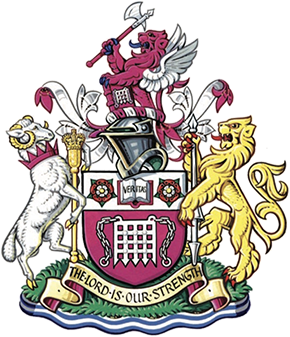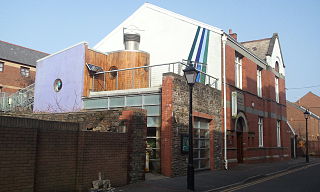
The National Trust for Scotland is a Scottish conservation organisation. It is the largest membership organisation in Scotland and describes itself as "the conservation charity that protects and promotes Scotland's natural and cultural heritage for present and future generations to enjoy".

The Irish Georgian Society is an architectural heritage and preservation organisation which promotes and aims to encourage an interest in the conservation of distinguished examples of architecture and the allied arts of all periods across Ireland, and records and publishes relevant material. The aims of this membership organisation are pursued by documenting, education, fundraising, grant issuance, planning process participation, lobbying, and member activities; in its first decades, it also conducted considerable hands-on restoration activities.

Ashton Court is a mansion house and estate to the west of Bristol in England. Although the estate lies mainly in North Somerset, it is owned by the City of Bristol. The mansion and stables are a Grade I listed building. Other structures on the estate are also listed.

Maggie's centres are a network of drop-in centres across the United Kingdom and Hong Kong, which aim to help anyone who has been affected by cancer. They are not intended as a replacement for conventional cancer therapy, but as a caring environment that can provide support, information and practical advice. They are located near, but are detached from, existing NHS hospitals.
An Taisce – The National Trust for Ireland, established on a provisional basis in September 1946, and incorporated as a company based on an “association not for profit” in June 1948, is a charitable non-governmental organisation (NGO) active in the areas of the environment and built heritage in the Republic of Ireland. It considers itself the oldest environmental and non-governmental organisation in the country, and is somewhat similar to the National Trust of England, Wales and Northern Ireland but based more directly on the National Trust for Scotland. Its first president was the prominent naturalist Robert Lloyd Praeger.

Bristol, the largest city in South West England, has an eclectic combination of architectural styles, ranging from the medieval to 20th century brutalism and beyond. During the mid-19th century, Bristol Byzantine, an architectural style unique to the city, was developed, and several examples have survived.

The University of Westminster is a public university based in London, United Kingdom. Founded in 1838 as the Royal Polytechnic Institution, it was the first polytechnic to open in London. The Polytechnic formally received a Royal charter in August 1839, and became the University of Westminster in 1992.

The Building Research Establishment (BRE) is a centre of building science in the United Kingdom, owned by charitable organisation the BRE Trust. It is a former UK government national laboratory that was privatised in 1997. BRE provides research, advice, training, testing, certification and standards for both public and private sector organisations in the UK and abroad. It has its headquarters in Garston, Hertfordshire, England, with regional sites in Glasgow, Swansea, the US, India, the Middle East and China.

The Bath Preservation Trust is a charity that is based in Bath, Somerset, England, which exists to safeguard for the public benefit the historic character and amenities of the city, a UNESCO World Heritage Site, and its environs. BPT is independent, funded by public membership, grants, donations and income from four museums that it operates in Bath: No. 1 Royal Crescent, the Museum of Bath Architecture, Beckford's Tower, and the Herschel Museum of Astronomy.
Save Britain's Heritage is a British charity, created in 1975 by a group of journalists, historians, architects, and planners to campaign publicly for endangered historic buildings. It is also active on the broader issues of preservation policy. SAVE is a registered charity governed by a board of trustees.

The Prince's Charities is a non-profit organisation that has associations with King Charles III. The Prince's Charities, supported by The Prince's Charities Foundation, is based in the United Kingdom and comprises 19 organisations of which Charles is patron or president, 18 of which were founded personally by him. The name derives from Charles's status as the Prince of Wales before his accession on 8 September 2022.

The Twentieth Century Society, founded in 1979 as The Thirties Society, is a British charity that campaigns for the preservation of architectural heritage from 1914 onwards. It is formally recognised as one of the National Amenity Societies, and as such is a statutory consultee on alterations to listed buildings within its period of interest.
The Wiltshire Historic Buildings Trust is a charitable organisation which works to preserve the architectural heritage of Wiltshire, in the West of England.

The London Welsh Centre is a community and arts centre on Gray's Inn Road, in the London Borough of Camden. The centre is owned and run by the London Welsh Trust.

The Environment Centre in Swansea, Wales, is an independent charity organisation for environmental information, education and activity. Environment Centre may also refer to the building the charity is located in.

Ringway Centre is a Grade B locally listed building located on Smallbrook Queensway in the city centre of Birmingham, England. The six-storey, 230 metres (750 ft) long building was designed by architect James Roberts as part of the Inner Ring Road scheme in the 1950s and is notable for its gentle sweeping curved frontal elevation.

The Roundhouse, formerly Corporation Wharf, is a crescent-shaped building located in the city centre of Birmingham, England.

The Art Deco in Mumbai, India style is a notable feature of the architecture of the city. It was used primarily for office buildings, residences and movie theaters, during a period when India was part of the British Empire. On 30 June 2018, an ensemble of such buildings were officially recognized as a World Heritage site by the UNESCO World Heritage committee held in Bahrain as the Victorian and Art Deco Ensemble of Mumbai.

Science House is a heritage-listed commercial building located at 157–169 Gloucester Street and Essex Street, in the inner city Sydney suburb of The Rocks in the City of Sydney local government area of New South Wales, Australia. It was designed by Peddle Thorp & Walker Architects and built in 1930 by John Grant and Sons, Master Builders. It was also known as Sports House from 1978–1991. The building is owned by Denwol, a property group owned and controlled by Phillip Wolanski AM. It was added to the New South Wales State Heritage Register on 10 May 2002.

The Sydney Water Head Office, now known as Kimpton Margot Sydney is a heritage-listed hotel, formerly an office building, located in the Sydney central business district in New South Wales, Australia. It was designed by Henry Budden & Mackey and built from 1938 to 1939 by Howie Moffat & Co, commonly called the Water Board Building and formally the Metropolitan Water, Sewerage and Drainage Board Headquarters. Following Sydney Water's relocation to Parramatta in 2009, it was converted into a hotel (as The Primus Hotel, part of a chain of hotels owned by the municipal government of Shanghai, while the adjoining 1969 office building was redeveloped to become the Greenland Centre. In 2021, Primus Hotel Sydney closed, and in 2022 the hotel re-opened as part of the Kimpton chain operated by IHG Hotels & Resorts.

















